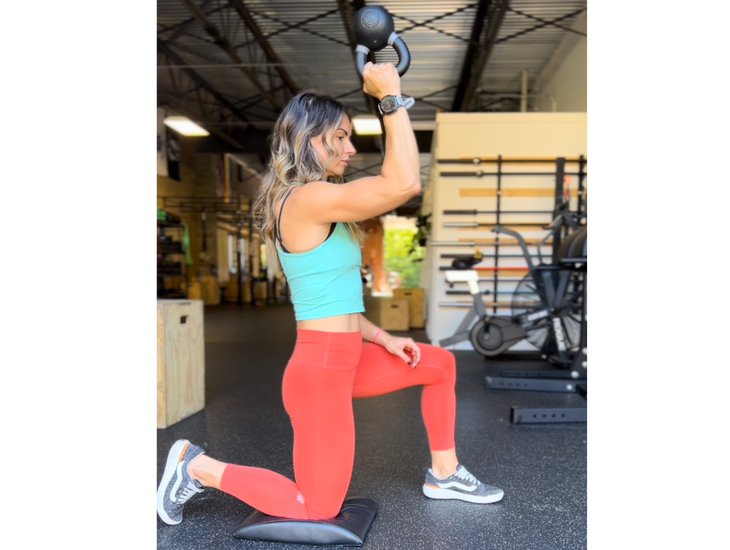No products in the cart.
Outdoor Adventure
3 Shoulder Stability Exercises for Athletes
The shoulder is one of the most mobile joints in the body, and excessive mobility demands stability. Many types of athletes—including climbers, cyclists, weightlifters, and triathletes—should build and maintain shoulder stability to prevent injuries.
If you use your upper body in any capacity while you exercise, even just for stabilization while your lower body does most of the apparent work, the muscles around your shoulder joints must be strong to support you during your daily activities.
As a physical therapist and CrossFit coach, shoulder injuries are the most common issue I see among athletes, especially seasoned ones. There are three main reasons for shoulder injury in my experience: poor mobility, inadequate strength, and improper form or bad lifting mechanics. Day-to-day movements, such as slouching while working, picking kids up with bad posture, or any repetitive movements, can also provoke injuries.
One or all of these things can be the culprit, and taking action before a minor ache turns into a serious issue can save you time, money, and stress. All it takes is some basic maintenance—and it doesn’t have to be fancy to be effective.
Here are three of my favorite tried-and-true shoulder stability movements I use with my clients:
1. Standing or Half-Kneeling Row/External Rotation/Press
This exercise is actually three movements that can be performed as a sequence or done individually. Make sure you can do each step with good form before putting them all together.
The target muscle groups are your posterior chain and the back, shoulder, and core muscles that support your rotator cuff. Strengthening these muscles is essential for many activities that require upper-body strength.
How to Do It
Get into a half-kneeling position, stepping forward with the foot opposite of the shoulder you plan to work. If half kneeling is too challenging for you, perform this exercise standing. Use a band that has anywhere from 10 to 30 pounds of resistance, depending on your upper-body strength.
For the first part of this exercise, hold the band with your arm straight out, shift your shoulder blade back, and perform a row while keeping your elbow and shoulder at 90 degrees. Hold his position for a three count.

Next, externally rotate your shoulder so that your palm is facing forward, and hold this position for another three count.

Finally, press up so that your elbow is fully straight and locked out by your ear. Hold for a three count in this position.

Aim to do three to four sets of 12 to 15 reps to build endurance. Move through each of these positions with good form, maintaining 90-degree angles at your shoulder and elbow. If you feel any pain, don’t push through it.
Tips: Maintain a neutral lumbar spine, avoiding any increased bending in your low back in this position. If your arm ends up slightly in front of you as you build strength, that is OK.
2. Bottom-Up Kettlebell Press/Static Hold in Half Kneeling
Nothing challenges overhead stability quite like an unfamiliar object. A kettlebell, if you have access to one, is an excellent tool to build overhead endurance and stability. This move can also be performed with a dumbbell held vertically for a similar effect.
The bottom-up kettlebell press and the static hold are both done while kneeling. This will not only challenge your shoulder stability, but also your midline and core control.
How to Do It
While half kneeling, position a kettlebell in the bottom-up position with the handle downward. Brace your core and press upward until your elbow is locked out next to your ear. Make sure you are not hyperextending at your lower back (Think: ribs down).

Lower the bell into the front-rack position with your shoulder and elbow at 90 degrees and your elbow facing forward. Press back up to the locked out position, and repeat until you’ve completed the target number of reps.

Perform three sets of eight per side, gradually increasing your reps to 12 to 15 before increasing the weight.
If pressing the kettlebell overhead is too difficult, try starting out with a static hold. Again, position the kettlebell in the bottom-up position, and get into half kneeling. Bring the kettlebell to the front-rack position with your elbow and shoulder at 90 degrees.
Here, retract your shoulder blade as you perform a static hold. (Think: pull the shoulder down and back.) Begin with 15 to 20 seconds, eventually progressing to three sets of 60 seconds.
Once you’re comfortable maintaining this position, revisit the bottom-up press to see if your shoulder has the stability to perform the full movement.
3. Scapular Y Raise
Another exercise I love for improving the strength and stability of your shoulder blade is a Y raise. This plane of motion (45 degrees in front of the body) is perfect for learning how to engage the scapular muscles, which are responsible for moving and supporting your shoulder blades.
How to Do It
Begin by squeezing your shoulder blades down and back to engage your scapular muscles.

With your thumbs pointed up, raise your arms into the Y position, to shoulder height, and hold at the top for a five count.

Slowly lower down with control. These holds at the top position promote endurance when performing other overhead movements in and out of the gym.
Begin with two sets of 15, eventually progressing to three sets of 15. Start with a light weight between one and five pounds—you will be surprised how challenging this exercise becomes through the repetitions, even with very little resistance.
Incorporate all of the above exercises into your routine to build shoulder stability and strength that will translate to all your favorite outdoor activities as well as your daily life.
Genevieve Gyulavary is a doctor of physical therapy, CrossFit Level I-certified trainer, and co-owner and coach at Timberhead CrossFit in South Windsor, Connecticut.
Source link

